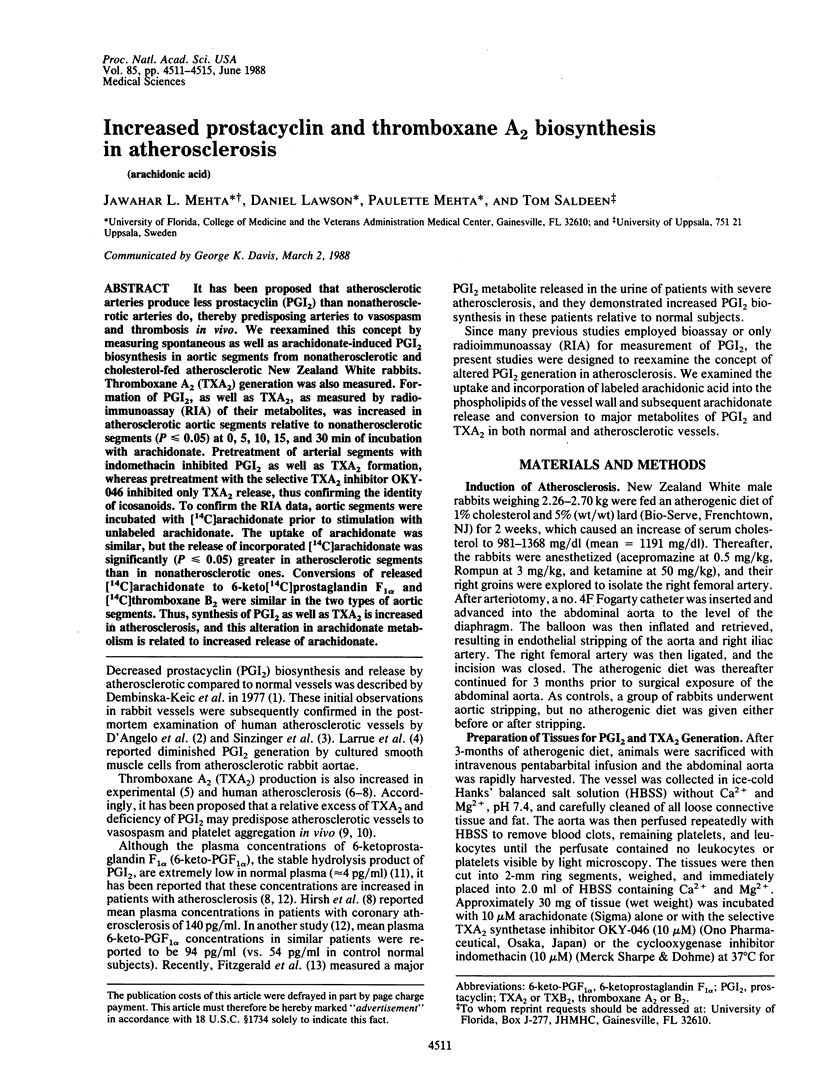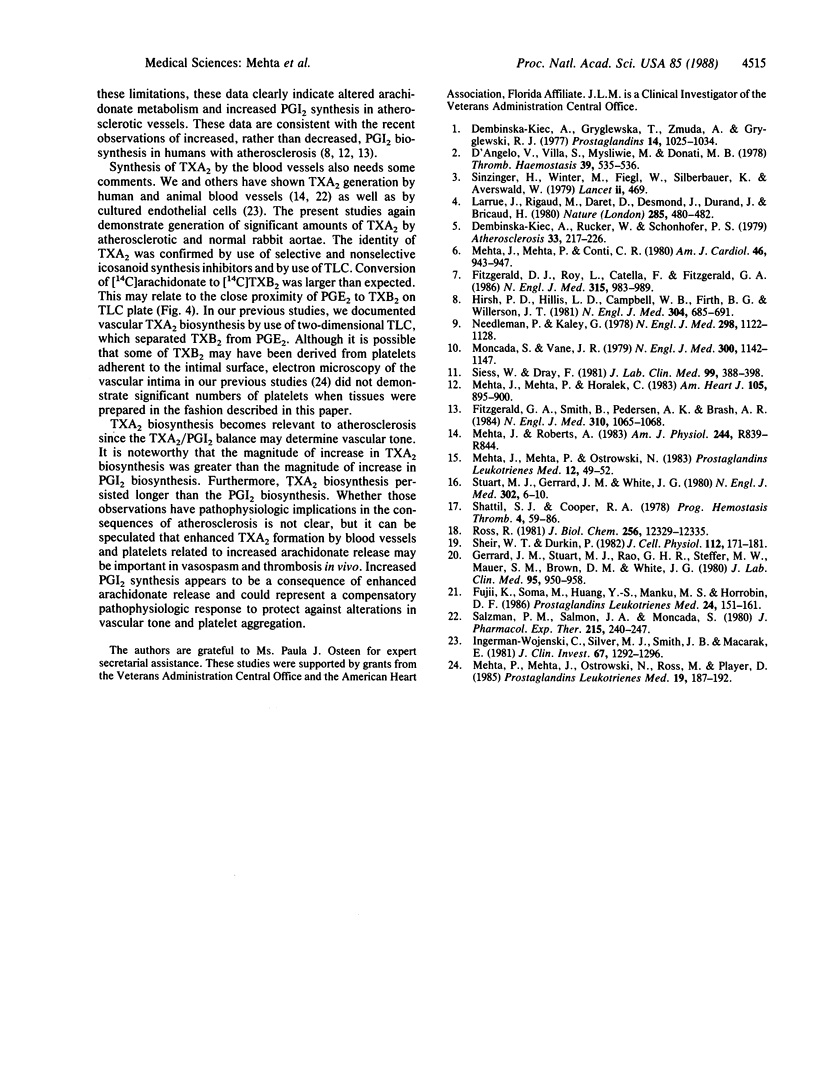Abstract
It has been proposed that atherosclerotic arteries produce less prostacyclin (PGI2) than nonatherosclerotic arteries do, thereby predisposing arteries to vasospasm and thrombosis in vivo. We reexamined this concept by measuring spontaneous as well as arachidonate-induced PGI2 biosynthesis in aortic segments from nonatherosclerotic and cholesterol-fed atherosclerotic New Zealand White rabbits. Thromboxane A2 (TXA2) generation was also measured. Formation of PGI2, as well as TXA2, as measured by radioimmunoassay (RIA) of their metabolites, was increased in atherosclerotic aortic segments relative to nonatherosclerotic segments (P less than or equal to 0.05) at 0, 5, 10, 15, and 30 min of incubation with arachidonate. Pretreatment of arterial segments with indomethacin inhibited PGI2 as well as TXA2 formation, whereas pretreatment with the selective TXA2 inhibitor OKY-046 inhibited only TXA2 release, thus confirming the identity of icosanoids. To confirm the RIA data, aortic segments were incubated with [14C]arachidonate prior to stimulation with unlabeled arachidonate. The uptake of arachidonate was similar, but the release of incorporated [14C]arachidonate was significantly (P less than or equal to 0.05) greater in atherosclerotic segments than in nonatherosclerotic ones. Conversions of released [14C]arachidonate to 6-keto[14C]prostaglandin F1 alpha and [14C]thromboxane B2 were similar in the two types of aortic segments. Thus, synthesis of PGI2 as well as TXA2 is increased in atherosclerosis, and this alteration in arachidonate metabolism is related to increased release of arachidonate.
Full text
PDF




Selected References
These references are in PubMed. This may not be the complete list of references from this article.
- D'Angelo V., Villa S., Mysliwiec M., Donati M. B., de Gaetano G. Defective fibrinolytic and prostacyclin-like activity in human atheromatous plaques. Thromb Haemost. 1978 Apr 30;39(2):535–536. [PubMed] [Google Scholar]
- Dembinska-Kiec A., Gryglewska T., Zmuda A., Gryglewski R. J. The generation of prostacyclin by arteries and by the coronary vascular bed is reduced in experimental atherosclerosis in rabbits. Prostaglandins. 1977;14(6):1025–1034. doi: 10.1016/0090-6980(77)90282-9. [DOI] [PubMed] [Google Scholar]
- Dembińska-Kiè A., Rücker W., Schönhöfer P. S. Prostacyclin-dependent differences in TXA2 formation by platelets from normal and atherosclerotic rabbits. Atherosclerosis. 1979 Jun;33(2):217–226. doi: 10.1016/0021-9150(79)90118-7. [DOI] [PubMed] [Google Scholar]
- FitzGerald G. A., Smith B., Pedersen A. K., Brash A. R. Increased prostacyclin biosynthesis in patients with severe atherosclerosis and platelet activation. N Engl J Med. 1984 Apr 26;310(17):1065–1068. doi: 10.1056/NEJM198404263101701. [DOI] [PubMed] [Google Scholar]
- Fitzgerald D. J., Roy L., Catella F., FitzGerald G. A. Platelet activation in unstable coronary disease. N Engl J Med. 1986 Oct 16;315(16):983–989. doi: 10.1056/NEJM198610163151602. [DOI] [PubMed] [Google Scholar]
- Fujii K., Soma M., Huang Y. S., Manku M. S., Horrobin D. F. Increased release of prostaglandins from the mesenteric vascular bed of diabetic animals: the effects of glucose and insulin. Prostaglandins Leukot Med. 1986 Oct;24(2-3):151–161. doi: 10.1016/0262-1746(86)90123-x. [DOI] [PubMed] [Google Scholar]
- Gerrard J. M., Stuart M. J., Rao G. H., Steffes M. W., Mauer S. M., Brown D. M., White J. G. Alteration in the balance of prostaglandin and thromboxane synthesis in diabetic rats. J Lab Clin Med. 1980 Jun;95(6):950–958. [PubMed] [Google Scholar]
- Habenicht A. J., Glomset J. A., King W. C., Nist C., Mitchell C. D., Ross R. Early changes in phosphatidylinositol and arachidonic acid metabolism in quiescent swiss 3T3 cells stimulated to divide by platelet-derived growth factor. J Biol Chem. 1981 Dec 10;256(23):12329–12335. [PubMed] [Google Scholar]
- Hirsh P. D., Hillis L. D., Campbell W. B., Firth B. G., Willerson J. T. Release of prostaglandins and thromboxane into the coronary circulation in patients with ischemic heart disease. N Engl J Med. 1981 Mar 19;304(12):685–691. doi: 10.1056/NEJM198103193041201. [DOI] [PubMed] [Google Scholar]
- Ingerman-Wojenski C., Silver M. J., Smith J. B., Macarak E. Bovine endothelial cells in culture produce thromboxane as well as prostacyclin. J Clin Invest. 1981 May;67(5):1292–1296. doi: 10.1172/JCI110157. [DOI] [PMC free article] [PubMed] [Google Scholar]
- Larrue J., Rigaud M., Daret D., Demond J., Durand J., Bricaud H. Prostacyclin production by cultured smooth muscle cells from atherosclerotic rabbit aorta. Nature. 1980 Jun 12;285(5765):480–482. doi: 10.1038/285480a0. [DOI] [PubMed] [Google Scholar]
- Mehta J., Mehta P., Conti C. R. Platelet function studies in coronary heart disease. IX. Increased platelet prostaglandin generation and abnormal platelet sensitivity to prostacyclin and endoperoxide analog in angina pectoris. Am J Cardiol. 1980 Dec 1;46(6):943–947. doi: 10.1016/0002-9149(80)90349-5. [DOI] [PubMed] [Google Scholar]
- Mehta J., Mehta P., Horalek C. The significance of platelet-vessel wall prostaglandin equilibrium during exercise-induced stress. Am Heart J. 1983 Jun;105(6):895–900. doi: 10.1016/0002-8703(83)90386-1. [DOI] [PubMed] [Google Scholar]
- Mehta J., Mehta P., Ostrowski N. Stimulation of vessel wall prostacyclin by selective thromboxane synthetase inhibitor OKY 1581. Prostaglandins Leukot Med. 1983 Sep;12(1):49–52. doi: 10.1016/0262-1746(83)90066-5. [DOI] [PubMed] [Google Scholar]
- Mehta J., Roberts A. Human vascular tissues produce thromboxane as well as prostacyclin. Am J Physiol. 1983 Jun;244(6):R839–R844. doi: 10.1152/ajpregu.1983.244.6.R839. [DOI] [PubMed] [Google Scholar]
- Mehta P., Mehta J., Ostrowski N., Ross M., Player D. Arachidonic acid and isolated human umbilical vein: concentration-limited prostacyclin generation and absence of direct toxic effects on endothelial integrity. Prostaglandins Leukot Med. 1985 Aug;19(2):187–192. doi: 10.1016/0262-1746(85)90085-x. [DOI] [PubMed] [Google Scholar]
- Moncada S., Vane J. R. Arachidonic acid metabolites and the interactions between platelets and blood-vessel walls. N Engl J Med. 1979 May 17;300(20):1142–1147. doi: 10.1056/NEJM197905173002006. [DOI] [PubMed] [Google Scholar]
- Needleman P., Kaley G. Cardiac and coronary prostaglandin synthesis and function. N Engl J Med. 1978 May 18;298(20):1122–1128. doi: 10.1056/NEJM197805182982005. [DOI] [PubMed] [Google Scholar]
- Salzman P. M., Salmon J. A., Moncada S. Prostacyclin and thromboxane A2 synthesis by rabbit pulmonary artery. J Pharmacol Exp Ther. 1980 Oct;215(1):240–247. [PubMed] [Google Scholar]
- Shattil S. J., Cooper R. A. Role of membrane lipid composition, organization, and fluidity in human platelet function. Prog Hemost Thromb. 1978;4:59–86. [PubMed] [Google Scholar]
- Shier W. T., Durkin J. P. Role of stimulation of arachidonic acid release in the proliferative response of 3T3 mouse fibroblasts to platelet-derived growth factor. J Cell Physiol. 1982 Aug;112(2):171–181. doi: 10.1002/jcp.1041120204. [DOI] [PubMed] [Google Scholar]
- Siess W., Dray F. Very low levels of 6-keto-prostaglandin F1 alpha in human plasma. J Lab Clin Med. 1982 Mar;99(3):388–398. [PubMed] [Google Scholar]
- Sinzinger H., Feigl W., Silberbauer K. Prostacyclin generation in atherosclerotic arteries. Lancet. 1979 Sep 1;2(8140):469–469. doi: 10.1016/s0140-6736(79)91520-4. [DOI] [PubMed] [Google Scholar]
- Stuart M. J., Gerrard J. M., White J. G. Effect of cholesterol on production of thromboxane b2 by platelets in vitro. N Engl J Med. 1980 Jan 3;302(1):6–10. doi: 10.1056/NEJM198001033020102. [DOI] [PubMed] [Google Scholar]


